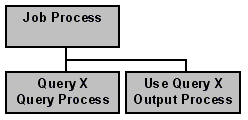Chapter 3-2: Getting Started |
Query Setup versus Execution A query process is comprised of the following two parts: Setup,which populates three temporary memory files that contain a query's sort and record selection constraints. It optionally displays Record Selection and Sort Order screens from which the application user can dynamically modify sort and selection criteria. Execution,which consists of the actual selecting and sorting of records in conformance with the criteria established during query setup. Query setup executes when a query process is invoked as an automatic child from another APPX process. Query execution is performed in conjunction with the process that uses the query. Following is an example of a process tree, with query and output processes executing as children of a controlling job process. Query setup executes first, permitting interactive editing of the query specifications (record selection criteria and sort order). Query execution is performed in conjunction with the subsequent output process that uses the query.
An Example Process Tree If a query process is not explicitly invoked as a child, query setup executes implicitly with query execution and in conjunction with the child process that uses the query. In such a case, query setup's Record Selection and Sort Order screens do not display to a user. It is important to note that, while queries execute at the same time as the first process that uses the query, Query Execution event points do not share record areas or record pointers with the other process. The two processes, the query, and the process using the queried records, can be considered to execute in parallel, communicating with one another only through the records that are retrieved. (The process requests a record from the query; the query returns a record.) Consequently, APPX cannot guarantee that the query, particularly the End of Query Execution event point, will complete before Start of Process for the process that is using the queried records. Therefore, you should not use a query to compute summary information for use by a subsequent process. |
Application Design Manual "Powered by Appx Software"280 ©2006 By APPX Software, Inc. All Rights Reserved |
